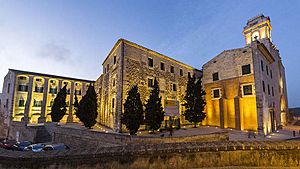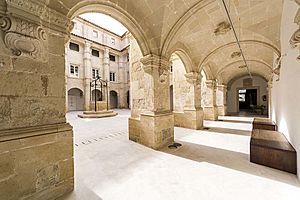Museum of Menorca facts for kids
Quick facts for kids Museum of Menorca |
|
|---|---|
| Native name Catalan: Museu de Menorca |
|

Museu de Menorca
|
|
| Location | Mahón, Spain |
The Museum of Menorca (also known as Museu de Menorca) is a special place in Mahón, Spain. It's like a time machine that helps us learn all about the prehistory and history of the island of Menorca. It's a public museum, which means it's for everyone to visit and explore!
Contents
What You'll Find Inside
The Museum of Menorca is located on Avenida del Doctor Guàrdia in Mahón.
Inside, you'll discover amazing objects from Menorca's past. These items come from old museum collections, recent archaeological digs, and even gifts from people and other groups.
The main exhibition was completely updated in 2017 and 2018. It reopened in July 2018, showing off all its new displays. The museum also has special temporary exhibitions on the ground floor, so there's always something new to see!
The Museum of Menorca is super important for sharing Menorca's history and culture. It also does a lot of research into the island's very early history, long before written records.
A Journey Through Time: The Museum's History
The museum we know today started a long time ago. Its first version was called the Municipal Museum of Mahón. It opened on November 4, 1889. A person named Joan Seguí Rodríguez helped start it, and its first collection came from private donations. Some of the very first items were pieces of Roman tombs found in Mahón.
Over the years, the museum's collection moved to different places. In 1906, it went to the Ateneo Museum. Then, in 1944, it became part of the new Provincial Museum of Fine Arts. This new museum found a home in the Can Mercadal palace in November 1948. Many more artifacts were added, making the collection much bigger.
From 1953 to 1967, under the guidance of M. Lluïsa Serra, the museum grew even more. It gained new artworks and also kept important archaeological finds from famous sites. These sites included places like Naveta d'Es Tudons (an ancient burial site), the Talatí de Dalt settlement, and old basilicas.
In 1975, the museum officially became the Museu de Menorca and joined the National Board of Museums. However, its building had problems and had to close. But don't worry! In 1980, the city of Mahón gave an old Franciscan convent building to the State. This beautiful old building became the museum's new and permanent home.
The government of the Balearic Islands started managing the museum in 1984. After some renovations, parts of the building reopened in 1986. The restoration of the cloister (a special courtyard) of Saint Francis even added new items to the museum's collection, like old pottery and colorful tiles.
Temporary exhibition rooms opened in 1995, and the main permanent rooms opened three years later. The new museum headquarters were officially opened then.
The museum's collection has continued to grow thanks to the hard work of many groups, including universities and archaeologists. Even artifacts found by archaeologist Margaret Murray in the 1930s were brought back from Cambridge to the museum!
Since 2007, a team of archaeologists from the museum has been working at a site called Cornia Nou. This is an ancient Talayotic settlement near Mahón, which has old buildings and structures.
The island's local government has managed the museum since 2011. In July 2018, the museum reopened after more updates, showing off its modern and exciting permanent exhibition.
The Museum's Home: An Old Convent
The museum is located in a very old building that used to be a Franciscan convent. This convent was built between the 17th and 18th centuries. The first convent on this spot was actually from the 15th century, but it was destroyed during a Turkish attack on Mahón in 1535.
The building where the museum is now was built later, and it was updated again in the early 1800s.
In the past, the ground floor of the convent had a reception area, a meeting room, a kitchen, a pantry, a cellar, a dining hall, and schools for grammar and philosophy. The friars (monks) had their cells and other rooms on the upper floors.
The Franciscans had to leave the convent in 1835. After that, the building was given to the city. Before it became the museum, it was used for many different things, like a house of charity, a sailing school, a public library, and even a high school!
The museum building has three floors that surround a beautiful, square-shaped cloister. This cloister has arches and a special wing to its south. You can see a mix of Classical orders (like ancient Greek and Roman building styles) and Baroque elements in its design. The temporary exhibition rooms and a meeting hall are on the ground floor, while the first and second floors hold the main permanent exhibition.
Learning and Research at the Museum
The Museum of Menorca is a very important place for studying the Prehistory, History, and culture of Menorca. It has a huge collection of about 200,000 objects! There's even a special area where researchers can study these artifacts closely.
The museum also has a library that's open to everyone. It has a large collection of books and documents about Art and Archaeology. You can also find books, journals, and guides about different parts of Menorca's History, Ethnography (the study of cultures), Geography, and Culture. Many of the archaeological books are very specialized and hard to find anywhere else on the island.
The museum regularly publishes scientific papers about archaeology, guides to its collections, catalogs for temporary exhibitions, and educational materials. These publications help everyone learn more about the history of Menorca.
Fun Visits and Activities
The Museum of Menorca offers different ways to visit, making it great for everyone!
- Guided Visits: If you're with a group, you can arrange a guided tour that's made just for your interests. These tours can even include a visit to the temporary rooms and the ancient site of Cornia Nou.
- Family Visits: Families can explore the museum with help from the staff or by asking for a guided tour.
- Group Visits: The museum can design special visits for groups, whether you want to explore on your own or have a guide.
- School Visits: For schools, the museum creates visits that focus on specific time periods. They design routes that are perfect for different age groups and student needs.
Besides visits, the Museum of Menorca also organizes many fun activities! These include:
- Workshops for children
- Gymkhanas (like treasure hunts!)
- Special "nights at the museum"
- Specialized visits for deeper learning
- Lectures and presentations about artifacts
The museum is a fantastic place to learn, explore, and have fun while discovering the rich history of Menorca!
See also
 In Spanish: Museo de Menorca para niños
In Spanish: Museo de Menorca para niños



